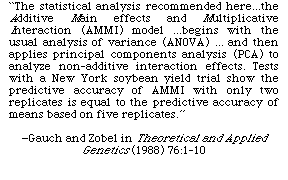
MATMODELTM
Version 2.0
by Hugh G. Gauch, Jr.
MATMODELTM offers new and exciting possibilities for effective research strategies involving two-way data tables, with or without replication.
See our FREE program YTDesign to design Yield Trials with or without MATMODELTM and compare the advantages of AMMI Analysis with MATMODELTM.
If you already have MATMODELTM or are curious where you can go with MATMODELTM output, you will want to look at the current beta of our FREE program AMMIWINS to take MATMODELTM output and optimize selection strategies.
The AMMI analysis implemented in MATMODELTM offers five substantial benefits to agronomists and breeders concerned with Genotype-Environment interactions:
MATMODELTM produces adjusted means which often have predictive accuracy equivalent to unadjusted means based upon a few or several additional replicates (see inset). Therefore, AMMI analysis can often improve accuracy as much as doubling the data collection effort.
Most strategies for improving accuracy require a particular experimental design, or else concomitant variables ranging from field maps locating each observation to additional data on soils, weather, or whatever. AMMI has no such requirements. AMMI is freely applicable to historical data, collected with any experimental design. Thus, AMMI is still useful when past data contribute to ongoing decisions. Moreover, the power of AMMI to extract additional information will often make hard-won historical data worthy of renewed attention.
Version 2.0 represents a considerable improvement over earlier versions, allowing and imputing missing data. It also provides tools for optimal model selection from among the family of AMMI models, including assessment of predictive accuracy using data splitting and validation. Efficient memory utilization allows for processing about 30,000 observations, depending on system configuration and details of the analysis.
